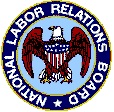Information contained in this publication is intended for informational purposes only and does not constitute legal advice or opinion, nor is it a substitute for the professional judgment of an attorney.
 The National Labor Relations Board has issued a new rule (pdf) outlining special procedures governing the filing of certain motions and appeals with the Board in the event it lacks a quorum and thus cannot exercise its full authority. It is anticipated that after Member Craig Becker’s term expires at the end of the year, the Board will be left with just two sitting members – Chairman Mark Gaston Pearce (D) and Brian Hayes (R) – unless the Senate confirms additional members and/or the President makes any recess appointments. House procedural maneuvers will likely prevent the latter from happening. In last year’s New Process Steel opinion, the Supreme Court held that the National Labor Relations Act requires that the Board operate with at least three members in order to be fully operational. The consideration of cases and issuance of decisions falls under the category of Board activities that requires three sitting members. To that end, the new rule, effective Dec. 14, describes the procedural routes that certain motions and appeals should take until the Board achieves at least a 3-member quorum.
The National Labor Relations Board has issued a new rule (pdf) outlining special procedures governing the filing of certain motions and appeals with the Board in the event it lacks a quorum and thus cannot exercise its full authority. It is anticipated that after Member Craig Becker’s term expires at the end of the year, the Board will be left with just two sitting members – Chairman Mark Gaston Pearce (D) and Brian Hayes (R) – unless the Senate confirms additional members and/or the President makes any recess appointments. House procedural maneuvers will likely prevent the latter from happening. In last year’s New Process Steel opinion, the Supreme Court held that the National Labor Relations Act requires that the Board operate with at least three members in order to be fully operational. The consideration of cases and issuance of decisions falls under the category of Board activities that requires three sitting members. To that end, the new rule, effective Dec. 14, describes the procedural routes that certain motions and appeals should take until the Board achieves at least a 3-member quorum.
Specifically, motions for default judgment, summary judgment, or dismissal of complaints will be referred to the Chief Administrative Law Judge (CALJ) in Washington, D.C. The CALJ’s rulings or related orders will not be appealable directly to the Board, but will be considered by the Board as part of the case record if exceptions to the rulings or orders are included in the statement of exceptions filed with the Board. Requests for special permission to appeal will be similarly referred to the CALJ.
In addition, any administrate and procedural motions ordinarily referred to the Office of the Executive Secretary for decision by the Board prior to the filing of a request for review will instead be referred to the Executive Secretary for ruling.
In each instance, normal time limits will apply, and the parties will retain the right to a full Board review by filing a request for review or exceptions to the rulings/orders. Once the Board achieves the necessary quorum, it will be able to consider the cases on their merits.
The changes offered by the Board here reflect what appears to be an attempt to continue limited operations once it consists of only two members. Even so, under such circumstances, it is likely that the execution of many of the Board’s customary functions such as those referred to in the rule will be deferred until it has returned to a quorum.


